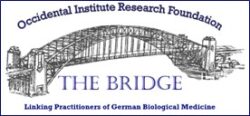Web Watch
Article Submitted by Dr. Sir Zenon W. Gruba, September 2008
Understanding the “L-Form” Bacteria
Targeting the Cause of Inflammatory Disease
In 2006, the Centers for Disease Control and Prevention (CDC) released a paper stating, “Infectious agents have emerged as notable determinants, not just complications, of chronic diseases. To capitalize on these opportunities, clinicians, public health practitioners, and policymakers must recognize that many chronic diseases may indeed have infectious origins.”
Multiple studies have shown that when Beta-lactam antibiotics are applied to wild-type bacteria in a Petri dish, small colonies of L-form bacteria form on the edges of the plate, indicating the possibility that such antibiotic treatment is not only incapable of resolving L-form infection, but in fact, it may induce L-form growth.
Researchers have currently identified over 50 different species of bacteria capable of transforming into the L-form. Among them include: Bacillus anthracis, Treponema pallidum, Mycobacterium tuberculosis, Helicobacter pylori, Rickettsia prowazekii, and Borrelia burgdorferi. It is likely that more species will be found in the coming years, especially if the widespread use of cell-wall targeting antibiotics continues.
Characteristics of L-form Bacteria
- Pleomorphic: They have the ability to change size and shape
- Smaller than viruses or fungal particles: They cannot be seen with a normal optical microscope.
- Cell wall deficient: They can no longer be killed by many commonly used antibiotics, which target cell walls.
- Lack flagella, the whip-like tail that enables bacteria to “swim”.
- Encased inside tubules, which enable them to evade the immune system.
Route of Infection
In addition to the morphing of regular-form bacteria into the L-form described above, these pathogens may also be contracted exogenously. Because they cannot be killed by pasteurization or chlorination, L-form bacteria can be found in milk, food and water. They can be transmitted via sperm, intimate contact, and can be passed from mother to child during childbirth. Since they are too small to be filtered during the purification processes used in pharmaceutical manufacturing procedures, they can be transmitted through injectable medicines. They have even been cultured from dry soil.
Pathogenesis
Once macrophages and other cells have been infected with L-form bacteria, the bacteria circulate in the blood and tissues. In some cases they7 cluster together in clumps called granulomas. In other cases, they accumulate in regions such as the joints.
The bacteria survive and replicate by:
Hijacking normal cellular processes to use to their advantage.
Mutating genes to produce proteins that disable innate immunity
Becoming encapsulated in fibrotic tissue.
Congregating into filamentous “biofilms”, in which they create a protective protein sheath
Delaying the process of apoptosis (programmed cell death).
After a successful invasion of the macrophages, the bacteria stimulate the activity of Nuclear Factor Kappa B. Once this occurs, NF Kappa B activates a variety of genes that cause the release of inflammatory cytokines, including TNF-alpha and interferon gamma, which produce the symptoms (swelling, pain, and fatigue) commonly observed in many autoimmune diseases.
Detecting the Infection
Once bacteria have transformed into the L-form they can no longer be detected by many standard laboratory procedures. Due to their inability to survive outside of a living cell, they can only be cultured on blood agar at very specific temperatures and at a certain pH. Since L-form bacteria are able to persist inside the macrophages for such extended periods of time, few of them die and only tiny amounts of L-form bacterial proteins and genetic material reach the bloodstream at any given time; an amount so small that a PCR test cannot pick them up. L-forms also cannot be detected with antibody testing, since antibodies only form in response to bacteria that have died. Since L-form bacteria are able to persist for such long periods of time inside the cells, very few antibodies are created in response to their presence.
The Vitamin D Metabolites Tests or using the MP as a therapeutic probe are currently the most effective methods for detecting these pathogens. Physicians must measure both 25-D and 1.25-D to observe the relationship between the two values.
 From an article found on the website for
From an article found on the website for
The Centers for Disease Control (CDC)
Re-pulished in THE BRIDGE Newsletter of OIRF
September 2008


